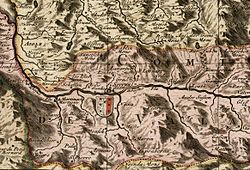République des Sept-Dizains
| Republic of the Seven Tithings | ||||||||||
| République des Sept-Dizains | ||||||||||
|
||||||||||
|
|
||||||||||
|
Map of the Upper Valais, detail from a 1693 map of the Swiss Confederacy and its associates.
|
||||||||||
| Capital | Not specified | |||||||||
| Government | Republic | |||||||||
| Historical era | Early Modern period | |||||||||
| • | Established | 1613 | ||||||||
| • | Disestablished | 1798 | ||||||||
|
||||||||||

coat of arms (1623)
The République des Sept-Dizains (German Republik der Sieben Zenden "Republic of the Seven Tithings") was a state in the Upper Valais, in what is now the Swiss canton of Valais, during the Early Modern period.
The seven tithings were Brig, Goms, Leuk, Raron, Sierre, Sion and Visp.
They emerged in the 14th century, and were granted certain privileges by Charles IV in 1353. These territories had enjoyed de facto independence since the later 15th century, seizing much of the Lower Valais formerly controlled by the House of Savoy in 1475. This happened in the context of the Burgundian Wars, and with the agreement of both the bishop of Sion and the canton of Berne.
The tithings gained further autonomy as a result of the conflict with bishop Matthäus Schiner after the Battle of Marignano (1515), and again with the constitutional establishment of the Zendenherrschaft (sovereignty of the tithings) in 1571. The conflict between the prince-bishops and the communes simmered on into the 17th century. In 1613, the bishop was forced to forfeit his claim on the tithings, at first temporarily, then permanently in 1634, marking the beginning of the de jure sovereignty of the tithings and the end of the secular power of the prince-bishops. The communes of the Valais first referred to themselves as a democratic Republic in a document of 1619; the distinctive seven-star coat of arms which forms the basis of the current cantonal coat of arms dates to 1628.
...
Wikipedia

